Bovine TB: Time to be bothered
How many psychologists does it take to change a lightbulb? Just the one, but that lightbulb has got to WANT to change, writes Rural Affair Editor Nathan Rous.
How many psychologists does it take to change a lightbulb? Just the one, but that lightbulb has got to WANT to change, writes Rural Affair Editor Nathan Rous.
As humans we fall into three categories: we're either 'for' something, 'against' something or not bothered. The only way our opinions alter is if the facts change.
Take BSE. A cow unable to keep its feet on the yard, stumbling like a panto dame in high heels, is splashed across the news and the nation is automatically split into three camps: those who burst into floods of tears at the animal's suffering; others who spat the burgers from their mouths and vowed to go vegetarian; and another group who flicked over impassively to catch the beginning of Home and Away.
Have your say in the Comment Box below
As the tabloids screamed hysterically about BSE, the then Minister of Agriculture, John Gummer, invited newspapers and camera crews to photograph him trying to feed a beefburger to his daughter, Cordelia, at an event in his Suffolk constituency.
Despite being just four years of age Cordelia had already developed a deep mistrust of politicians, even though it was her father proferring the burger, and refused point blank.
Again, you were split into three camps: those who thought there was a sinister backbone to the saga if the Government was trying to put a positive spin on the story; those who considered the force-feeding of a four-year-old to be morally wrong; and others who thought she was wearing a pretty dress.
But just like our old friend the lightbulb, things soon changed once stories started running on the human variant of BSE - Creutzfeldt Jakob Disease.
In 1996, a decade after 'mad cow disease' was first identified in cattle, the Government admitted that CJD victims had probably caught the disease by eating meat from BSE infected cattle.
There was still the 'for and against' brigade; one group who ditched beef from their diet completely and another who bought more to support Britain's farmers. But it's that last group which suddenly sat up and took notice.
In a flash the 'not bothered' had become 'bothered' and swiftly allied themselves to whichever group they felt most comfortable with.
Now let's move that model forwards to the bovine TB debate, which has raged and frothed, just like the animals which catch it, for a good many year.
Once more the good British public fall into three camps: you want to protect badgers and will fight against a cull until your dying day; you want to protect cattle and will fight for a badger cull until your dying day; or you don't care remotely about either.
Yet I wonder whether that last group will take interest from the latest reports from Cornwall which revealed that a veterinary nurse and her dog have contracted bovine TB.
This is not an attempt to cause alarm or distress, to make you panic, or, at the very worst, encourage those who couldn't careless to get their backsides off the fence, but it is a chance to put the facts in front of you.
The incident was made public only after Defra confirmed that it had started an investigation into how the disease had crossed from animal to human.
It is extremely rare for people to contract the disease, but there is a greater risk for farmers and vets who work closely with infected animals.
According to the Health Protection Agency, in 2006 there were 33 cases of bovine TB in humans reported in Britain. Exact locations have not been revealed but given that north and south Shropshire are confirmed hotspots, a human variant of bovine TB may well be on our doorsteps.
Last year there were 4,137 outbreaks, a record in modern times, and 28,175 cattle were slaughtered as a result at a cost of millions to us all.
Farmers claim that badgers spread TB by urinating on the fields grazed by cattle. Conservationists, though, believe that the disease is spread between cattle themselves and exploded only after 2001, when farmers restocked their herds after the foot and mouth crisis.
Roger Sainsbury, a former government veterinary officer who specialised in bovine TB for 30 years, said "My real concern is that the number of cases in humans could increase because of the high incidence of TB in the environment.
"You could get contamination anywhere these days, even in a children's sandpit, and disease can be transmitted through a cut," he said.
"This is a very serious problem. We could do something about it but we are not and that is a travesty."
Funny how some of you thought bovine TB was of no relevance. Time to change the lightbulb.



